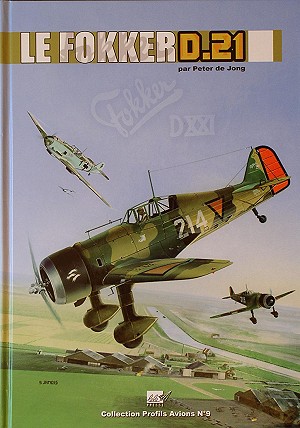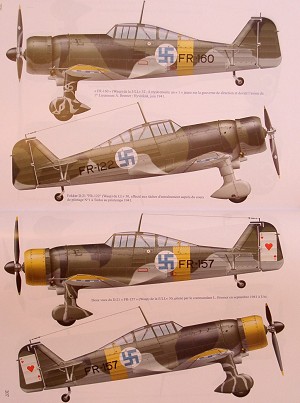 29 chapters and appendixes guide us in this study:
29 chapters and appendixes guide us in this study:| Title: | Le FOKKER D.21 |
| Authors: |
Peter DE JONG (translated by Michel LEDET) |
| Publisher |
LELA PRESSE |
| Price |
Approx 54 $ USD |
| Reviewer: | Jean Paul Poisseroux |
|
Notes: |
ISBN 2.914017-26-x |
Characteristics:
A-4 format, hard cover, 224 pages, 21pictures in color, 363 in b/w, 13 drawings (6 in 1/72 scale), 1 upper/under view, 27 color profiles, 2 “A-3” format 3D cutaways( Mercury and Wasp versions). French text with English translation aside pictures.
On 11 may 1940, 24 hours after the invasion of the Low Countries by the Germans, only 12 Fokker D.21 out of 36 are still operational, air combats, straffing and bombing swept the rest of this neutral country air force from the sky. One could have thought that the story will end there on the burned ashes. On the contrary, the war continued under other flag, in a north colder country; in the hands of the Finnish pilots.
Up to this day, Fokker is especially well known with its WWI fighters, D VII and Triplane DR.1. The D.21 (also written D.XXI) only appears in an ex “Eastern block” small monography, and in 2 volumes from Kari Stenman, devoted to Finnish war.
This new book from Lela Presse publishing is the first to cover the entire career of this aircraft with all Air Forces which engaged it in operations, The Netherlands, the Danish, the Finnish.
 29 chapters and appendixes guide us in this study:
29 chapters and appendixes guide us in this study:
1 - The scene and the actors
2 - The projects
3 - Birth of the D.21
4 - Trials
5 - First orders
6 - On line production
7 - In India and Spain
8 - Projects
9 - The Netherlands - 1938-1939
10 - Piloting the D.21
11 - In Finland - 1937-1939
12 - The Winter war
 13 - Danemark
13 - Danemark
14 - The Netherlands - 1939 -1940
15 - A sunny day in May
16 - Buiksloot and Brandenburg
17 - In Finland - 1940-1941
18 - The Continuation war
19 - The end
In the 63 first pages deals with the origin, birth and test of the type 21, which led to already consider it as a second rank fighter for Air Force which could have found a faster fighter in the meantime, at least delivered before the dark clouds which approached the West in the phoney war during 1939-1940. War pictures really arrived with chapter 9, when the Netherlands engaged its Air Force policy in the skies, after the invasion of Poland on 3 September 1939. For the Finns, it really begin some days after, on 30 September, with the Russian raids on Helsinki. After 105 days on the ridge, 127 victories were claimed, during 2477 sorties, for the lost of only 12 D.21!. In the West, the 10 may 1940 night turn from a bad dream to reality in some hours only. A chock, a wave that allied had difficulties to analyse and contain. Wreckage, fuselage skeletons are well known now, and the D.21 couldn't avoid this storm. In that summer, the Netherlands AF ceased to exist, the Danish are grounded by occupant, but the Finns count again on this fighter!. So the book turn on this front war and point well on different versions from the original D.21. We discover it with the Twin Wasp engine (and modifications), and even with a retractable undercarriage (a good conversion for a rare and unusual aircraft). The black and white pictures will be very useful for modeller to display the beautiful bird in its environment, on spring or in winter, hidden by forest, and painted with temporally water based white, with fixed skid skis. If you want to go further in peace time, the D.21 also serve with little national roundels until 1948. All this development lead us to page 169, where one step on a well considering “modelling chapter”. We find the most comprehensive documentation on the subject, for the numerous 1/72 scale models, as for the only Classic Airframe kit in 1/48 scale available today.
Color pictures from restored aircrafts under Netherlands and Finnish schemes, b/w wartime factory on line details, from fuselage to the wings. A long listing recall the fleet manufactured and open to big size profiles (almost a plain vertical A4 format), which cover every AF with all camo types, and aircraft mark covered in the different chapters above. The good 1/72 scale drawings depict there the contours, with engines, skis, and retractable gear amazing project. The four last pages are two A-3 format 3D skeletons views which display the interior lay-outs, a very comprehensive way to improve the mercury/wasp powered aircrafts kits.
In summary, this book is definitively THE reference for a long time for this aircraft lovers, and for all fans of WWII searching something more original than the mainstream “top 10” already over-covered. With this one, you can’t really say << oh, once more on the pile!>>.
Available at:
October 2005
If you would like your product reviewed fairly and quickly by a site that has around 300,000 visitors a month, please contact me or see other details in the Note to Contributors.